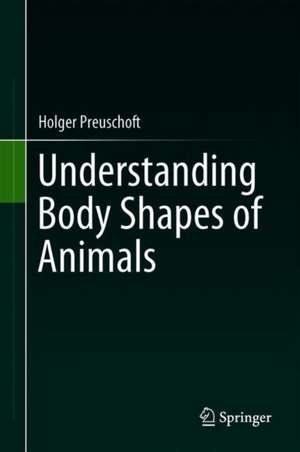Understanding Body Shapes of Animals: Shapes as mechanical constructions and Systems moving on minimal energy level
Autor Holger Preuschoften Limba Engleză Hardback – 29 iun 2022
The book explains morphological traits in more biomechanical detail without getting lost in physics, or in methods. Most emphasis is placed on the proximate question, namely the identification of the mechanical stresses which must be sustained by the respective body parts, when they move the body or its parts against resistance.
In the first part of the book the focus is on ‘primitive’ animals and later on the emphasis shifts to highly specialized mammals. Readers will learn more about living and fossil animals. A section of the book is dedicated to human evolution but not to produce anotherevolutionary tree, nor to refine a former one, but to contribute to answering the question: “WHY early humans have developed their particular body shape".
Preț: 1307.28 lei
Preț vechi: 1376.09 lei
-5% Nou
Puncte Express: 1961
Preț estimativ în valută:
250.15€ • 261.71$ • 207.80£
250.15€ • 261.71$ • 207.80£
Carte tipărită la comandă
Livrare economică 02-16 aprilie
Preluare comenzi: 021 569.72.76
Specificații
ISBN-13: 9783030276676
ISBN-10: 3030276678
Pagini: 581
Ilustrații: XIV, 581 p. 222 illus.
Dimensiuni: 155 x 235 mm
Greutate: 1.01 kg
Ediția:1st ed. 2022
Editura: Springer International Publishing
Colecția Springer
Locul publicării:Cham, Switzerland
ISBN-10: 3030276678
Pagini: 581
Ilustrații: XIV, 581 p. 222 illus.
Dimensiuni: 155 x 235 mm
Greutate: 1.01 kg
Ediția:1st ed. 2022
Editura: Springer International Publishing
Colecția Springer
Locul publicării:Cham, Switzerland
Cuprins
Chapter1: Why this book?.- Chapter2: Head.- Chapter3: Axial skeleton in aquatic animals.- Chapter4: Axial skeleton and muscle arrangement in terrestrial tetrapods.- Chapter5: What have the extremities of “lower tetrapods” in common? And Why?.- Chapter6: Birds.- Chapter7: Land-living mammals.- Chapter8: Primates, the group including humans.- Chapter9: Evolution of hominids.- Chapter10: Summary, Conclusions and Open questions.
Notă biografică
Prof. Dr. Holger Preuschoft is an Emeritus Professor at the Center for Anatomy, Ruhr-Universität in Bochum, Germany. 13 years back he was awarded the title "Docteur honoris causa" by the Université Louis Pasteur in Strasbourg, France. He has published more than 196 papers, and edited 9 multi-author books over the course of his career.
Textul de pe ultima copertă
This book discusses how and why animals evolved into particular shapes. The book identifies the physical laws which decide over the evolutionary (selective) value of body shape and morphological characters. Comparing the mechanical necessities with morphological details, the author attempts to understand how evolution works, and which sorts of limitations are set by selection.
The book explains morphological traits in more biomechanical detail without getting lost in physics, or in methods. Most emphasis is placed on the proximate question, namely the identification of the mechanical stresses which must be sustained by the respective body parts, when they move the body or its parts against resistance.
In the first part of the book the focus is on ‘primitive’ animals and later on the emphasis shifts to highly specialized mammals. Readers will learn more about living and fossil animals. A section of the book is dedicated to human evolution but not to produce anotherevolutionary tree, nor to refine a former one, but to contribute to answering the question: “WHY early humans have developed their particular body shape".
The book explains morphological traits in more biomechanical detail without getting lost in physics, or in methods. Most emphasis is placed on the proximate question, namely the identification of the mechanical stresses which must be sustained by the respective body parts, when they move the body or its parts against resistance.
In the first part of the book the focus is on ‘primitive’ animals and later on the emphasis shifts to highly specialized mammals. Readers will learn more about living and fossil animals. A section of the book is dedicated to human evolution but not to produce anotherevolutionary tree, nor to refine a former one, but to contribute to answering the question: “WHY early humans have developed their particular body shape".
Caracteristici
Simplifies a complicated picture of why a particular shape has evolved into its current form Provides an interdisciplinary approach that integrates mechanics into biology, anatomy and paleontology Presents zoological, primatological and anthropological aspects of functional morphology
